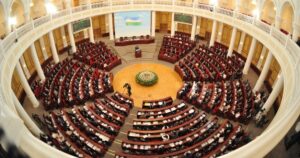
In 2024, the owner of the online medical goods ordering service tabletki.ua, MTPK LLC (Kyiv), increased its net profit by 1.96 times compared to 2023 – up to UAH 598.228 million.
This is evidenced by the data of the opendata.bot system.
According to the system, the company’s revenue increased by 1.95 times to UAH 715.433 million.
As reported, in February, Kyivstar, the largest mobile operator, applied to the Antimonopoly Committee of Ukraine (AMCU) with a second application for the purchase of MTPC LLC. Kyivstar filed its first application for the acquisition of MTPC in November 2024, but on November 29, the Committee returned it as not meeting the requirements of the regulation on the procedure for reviewing applications and cases on the concentration of business entities.
Tabletki.ua is a website and app that allows you to find and book medicines and pharmaceuticals at a particular pharmacy.
According to the service, by the end of 2023, the service had more than 10 million users and more than 12 thousand partner pharmacies.
The owners of MTPK LLC are Oleksandr, Natalia and Yevhen Muravschyk (23%, 23% and 10%, respectively), Yuriy Savin (20%), Volodymyr Osmachko (15%) and Vadym Rohatynskyi (9%).

For the first time in the history of Central Asia, the 150th anniversary assembly of the Inter-Parliamentary Union will be held in Tashkent.
This event will be held on April 5-9, 2025 at the Congress Hall in Tashkent City. About 2,000 delegates from 180 countries, 15 observer states, and more than 25 international and inter-parliamentary organizations are expected to attend.
The main theme of the upcoming Assembly will be “Parliamentary Movement for Social Development and Justice”. The Assembly will discuss issues such as poverty reduction, creation of decent working conditions, support for social inclusion, and increased participation of vulnerable groups in decision-making.
The Assembly will result in the adoption of IPU resolutions and the Tashkent Declaration.

In 2024, the German residential real estate market faced a number of challenges, including falling prices, slowing construction and rising borrowing costs. Here are the key trends and forecasts for 2025, focusing on the country’s largest cities.
Decline in housing prices
In the first half of 2024, the average asking prices for new and existing apartments decreased by about 3.6% compared to the same period in 2023. This decline is less pronounced than in previous periods, when the drop reached 7.3% and 7.4%, respectively. The largest annual decline was recorded in Frankfurt am Main – by 6.5%, while in Hamburg the decline was only 0.6%.
The situation in major cities
Munich: The most expensive city in Germany with an average price of about 11,000 euros per square meter. In 2024, there was a 5.2% decline in prices for new buildings.
Berlin: The average housing price was around 7,920 euros per square meter.
Hamburg: A 5% decline in new construction prices, which is one of the smallest declines among major cities.
Frankfurt am Main: The largest year-on-year price decline of 6.5%.
Düsseldorf and Leipzig: On the contrary, these cities recorded an increase in prices for new buildings by 4.1% and 8.7%, respectively.
Housing shortage and construction activity
According to a study by the Federal Institute for Building, Urban and Spatial Research (BBSR), Germany needs to build 320,000 new apartments every year until 2030 to meet growing demand, boosted by the influx of immigrants from Ukraine and Syria. However, in 2024, only 216,000 apartments were authorized, the lowest number since 2010 and reflecting the real estate crisis.
Financial performance and investments
Germany’s largest real estate group, Vonovia, reported its third consecutive annual loss in 2024, amounting to EUR 962.3 million, due to significant write-downs in property values. Nevertheless, CEO Rolf Buch predicts a return to profitability in 2025, provided that real estate prices stabilize.
Forecast for 2025
German house prices are expected to grow by 3.5% in 2025, although there is a significant risk of weaker growth. The market continues to face difficulties due to high borrowing and construction costs. Rental growth is expected to exceed house price growth, making it difficult for potential buyers to save a down payment.
In general, the German residential real estate market in 2024 was characterized by declining prices and slowing construction activity. Forecasts for 2025 suggest a moderate increase in prices, but the market remains sensitive to economic and political factors.
Source: http://relocation.com.ua/analysis-of-residential-real-estate-market-in-germany/

Ukrtruboizol, a research and production enterprise with foreign investments, has launched a new workshop for the production of polyethylene and pre-insulated pipes intended for main water supply and heating networks in housing and communal services.
According to a press release, the investment in the new project is more than UAH 150 million, including a 1.3 MW solar power plant that provides electricity to the new shop.
Dmytro Kysylevskyi, Deputy Chairman of the Verkhovna Rada Committee on Economic Development, announced this on his Facebook page.
According to him, the design capacity of the new shop is to produce 1200 mm diameter polyethylene pipes with a volume of up to 3.5 km per month, as well as 133 mm diameter pre-insulated pipes with a volume of 12 km per month. The shop will employ 30 people.
To partially finance this project, Ukrtruboizol took advantage of the government’s 5-7-9 affordable loan program. This program is part of the Made in Ukraine policy and allows manufacturing companies to receive concessional loans of up to UAH 150 million for investment needs.
Ukrtruboizol is Ukraine’s largest producer of large-diameter (426-1422 mm) longitudinal SAW steel pipes with anti-corrosion external and internal coating. The company employs 200 people.
The company is owned by individuals Sergiy Krasnopilsky and Igor Bilakovsky with 31.40% each, and Nikolay Kundiev with 27.4%.

“Nova Poshta, the largest logistics operator in Ukraine, has opened its first stationary branch in the Netherlands in Utrecht, and plans to open mini-branches in Amsterdam, The Hague, and Rotterdam by the end of the year. “Nova Poshta entered the Dutch market in October 2024 by launching fast targeted delivery services. The company is currently expanding its customer experience and has opened its own branch in Utrecht,” the press service said in a statement on Monday.
According to it, the branch is located at Overvliet, 2 and is open from Monday to Friday from 09:00 to 20:00, and on Saturday from 09:00 to 18:00.
Customers can send and receive documents and parcels weighing up to 100 kg at the branch.
Delivery time from Ukraine to the Netherlands is 6 days or more.
“We always strive to provide choice and convenience for our customers. That is why, in addition to fast targeted delivery, we have opened a branch in Utrecht. We see a great interest in the services of Nova Poshta from local residents, so we plan to expand further by opening mini-branches in the largest cities of the country: Amsterdam, The Hague, and Rotterdam this year,” the press service quoted Anton Chernysh, CEO of Nova Post in the Netherlands, as saying.
It is noted that each parcel is insured at the company’s expense. In the event of damage or loss, Nova Poshta guarantees full reimbursement of the estimated cost of the shipment.
It is also reported that Nova Poshta customers can call a courier to any address in the Netherlands to pick up a paid and packaged shipment. This can be done through a multilingual website, personal account or mobile application available on Google Play and the Apple Store.
The company’s digital services also allow you to create invoices, find the nearest service points, find out their working hours, and track the parcel’s movement in real time. You can pay for delivery online, including through the IDEAL payment system.
The cost of delivery between European countries is determined by the weight of the parcel and the distance to the destination country. Tariffs can be found here: https://novaposhta.ua/delivery_to_Netherlands/.
Earlier it was reported that Nova Poshta has launched courier delivery in the Netherlands, and in the near future plans to open its own branches in Amsterdam and Utrecht.
Source: http://relocation.com.ua/new-post-opens-first-stationary-office-in-utrecht-the-netherlands/

Last year, BUSIN Insurance Company (Kyiv) collected UAH 397.48 million in gross premiums, which is 35.55% more than in the same period of 2023, the Expert Rating agency reported in information on updating the insurer’s financial strength rating at the level of “uaAA” on the national scale based on the results of the specified period.
At the same time, revenues from reinsurers in 2024 increased by 55.2% to UAH 301.020 million, and the ratio between premiums due to reinsurers and gross premiums increased by 9.59 percentage points (p.p.) to 75.73%.
During this period, the company paid UAH 32.304 million in insurance claims and indemnities to its clients, compared to UAH 1.317 million in 2023.
RA also reports that last year the equity of BUSIN decreased by 19.94% to UAH 157.91 million, while its gross liabilities increased by 14.26% to UAH 133.48 million. The multidirectional movement of indicators led to a decrease in the ratio between equity and liabilities by 50.55 percentage points to 118.3%.
As of January 1, 2025, the amount of cash and cash equivalents on the company’s accounts remained virtually unchanged and amounted to UAH 253.78 million, and the level of cash coverage of liabilities decreased by 27.88 pp, to 190.13%.
According to the results of 2024, Busin’s activities were unprofitable, while in 2023 the insurer received net and operating profits. In particular, the loss from operating activities of the insurer for 2024 amounted to UAH 37.56 million, and its net loss amounted to UAH 27.29 million.
BUSIN Insurance Company was registered in February 1993. It specializes in risky types of insurance. It is a member of a number of professional and industry associations: League of Insurance Organizations of Ukraine, Insurance Claims Club, International Association of Aviation Insurers (UA), Nuclear Insurance Pool, American Chamber in Ukraine, British Business Club.